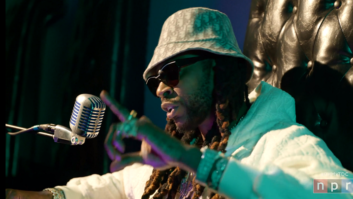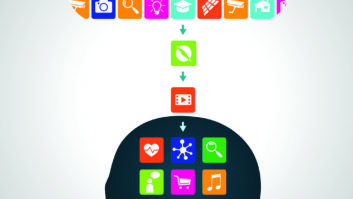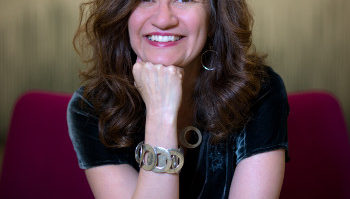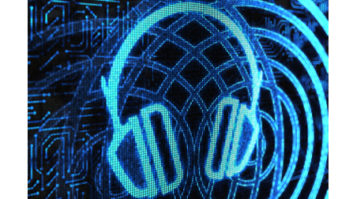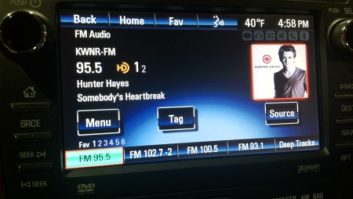It’s easy to get caught in the cycle of keeping up with the Joneses. Buzzwords and trends offer the promise of the new and the next, but for long-term success, it’s crucial to know your audience and to know your own passion.
Case in point: Bob Boilen and the evolution of “All Songs Considered.”

Tiny Desk Concert with Anthony D’Amato. Kevin Wait is visible in the center of the photo, wearing a black shirt.
Photo by Claire Eggers/NPR Boilen is the host and creator of both “All Songs Considered” and the Tiny Desk Concerts live perfomance series. In the course of his 27-year public radio career, he has worked his way up through the organization from “All Things Considered” assistant producer — Boilen jokes that his unofficial title was “tape cutter” — to director of “All Things Considered,” to his current role.
When Boilen took the reins of the signature newsmagazine, he was put in charge of selecting the songs that played between stories. He remembers that artists were sending in many more songs than he had time to use on the air (a good problem that he says has intensified over the years). These songs also generated a lot of listener engagement — which in the 1980s and ’90s meant hand-written letters. Boilen got the distinct impression that listeners were “music starved,” but affiliate stations were not interested in a music show produced by NPR.
However, in the late ’90s, when “the Internet was beginning to take shape,” Boilen says he “thought it would be really cool to do an Internet-only music show.” A self-professed tech junkie, he saw the potential to “narrowcast” on the Internet.
“Given the whole country, we could find enough people who had enough interest in one show,” Boilen explains.
ALL SONGS CONSIDERED
In 1999, Boilen pitched the idea, which he says was greeted with “resistance and puzzlement.”
After all, “remember what bandwidth was like in the year 2000.” Compounding the difficulties of 14.4k modems was Boilen’s goal of a one-hour multimedia slideshow featuring images and words, as well as the songs. Despite these obvious challenges, NPR offered support for the endeavor because “it’s the nature of the organization,” he says.
Boilen then put the initial episode of “All Songs Considered” online the first week of 2000.

Tiny Desk Concert with Anna & Elizabeth on April 17, 2015. Maggie Starbard is shown at far right. Boilen explains that this endeavor posed little risk for either NPR or for his career. Initially, he spend a few hours per week producing “All Songs Considered.” It was essentially a side gig as he continued to direct “All Things Considered.” In late 2000, Robin Hilton was hired as a producer, taking on much of the show’s Web work.
For two years, Boilen and Hilton worked on the multimedia show, a process that Boilen remembers as “a beast” because of what it took to get the necessary permissions, write the copy and build the slideshow.
“A lot of people probably weren’t watching the multimedia show because they were still on dial-up. We were really limited in what we could do because of the tech at the time. But as bandwidth grew, so did our imaginations,” Hilton says.
The pair wanted to produce “All Songs Considered” more often — which would require dropping the slideshow and doing “basically a radio show,” according to Boilen. They polled their audience and the results were clear: a weekly 40-minute, audio-only program was preferable to a bimonthly multimedia one.
PODCASTING
In August 2005, the first “All Songs Considered” podcast became available, which came with a new set of music rights issues, including the need to get permission to play all the songs in a downloadable show.
“But we won lots of battles along the way of getting music on, full songs, online and on podcasts quicker than anyone else did,” Boilen notes. “And part of the reason we did that is because people like NPR. And they like their music and respect it. They know it’s not going to be wrapped in a Coca-Cola ad, and they’re appreciative of that. And they trust us.”
That same year, Boilen and co. began broadcasting live concerts, starting with the 9:30 Club in Washington. In 2008, they started to cover music festivals — an effort that today has expanded to include Bonnaroo, Sasquatch, Newport and SXSW, among others. They also added a blog around that time.
The first Tiny Desk Concert (a name inspired by Boilen’s own former band, Tiny Desk Unit) was filmed in March 2008 and went online in April, adding video to an already extensive repertoire. The project was cofounded with Stephen Thompson, an editor and reviewer for NPR Music.
“There’s something about video that attracts people who may not take a gamble on a band that they’ve never heard of, but by seeing them I think they’re drawn to it,” Boilen says. “And also the intimacy of it gives them a better shot at liking it.”
Earlier in his professional life, Boilen had a music video show on a local TV station in Washington that he produced called “Captain Fogel’s Music Machine.” Perhaps because of this experience, Boilen says, “The marriage of the two was always sort of natural for me. And so Tiny Desk seemed a perfect thing to do a video of. But it was also important to keep it simple …. I wanted to be able to film and produce and do it all, and be able to produce one of these things in the morning, or in afternoons, I did not want it to be complicated. It was really important to be able to turn it around quickly.”
Initially, Boilen served as the audio engineer, one of two camera people, video editor and sound engineer. He also uploaded the “Tiny Desk” shows.
That same spirit remains a goal for Tiny Desk today, even though the concert series has a team of people involved in its production.

Tiny Desk Concert with John Reilly & Friends on Jan. 28, 2015.
Photo by Colin Marshall/NPR SIGNATURE SOUND
As audio technical director, Kevin Wait was integral in making sure that the sound of Tiny Desk Concerts and other NPR Music projects retain that “signature audio quality.” Wait is now working as an audio trainer for NPR, and Josh Rogosin has taken over as the lead audio engineer for NPR Music.
However, he says, “A day in the life of the audio technical director is basically chasing a calendar.”
Wait explains, “Bob Boilen is booking acts all the time. And he doesn’t tell us. He just plops them on the calendar — and if we’re lucky, we’ll have a meeting that week where we could sort of prepare for things. And within those [calendar] entries, he includes basically what is going on with the band.”
However, the key is to expect the unexpected. The very nature of the Tiny Desk Concert is meant to help artists feel laid back and at home in an unconventional space.
“So typically we’ll start to set up maybe an hour or two before downbeat, depending on when the band arrives,” Wait says. “That’s also a critical moment, because that’s when we really find out what’s going to happen. And part of the magic of the Tiny Desk is you’re just never really sure who’s coming and what they’re bringing and what they’re going to do. And I think Bob likes it that way.”
Wait says that the original Tiny Desk sound “was very organic, very simple” because they “used to try to shoot with one mic.” However, “now that the video kids have switched to high definition, I think there’s an emphasis on better audio as well. And we’ve also moved from … mostly acoustic, very quiet, self-balanced acts to DJs and electronics and electric instruments.
“I never want to say ‘no’ to anything that music wants to do. But what that requires is building a toolbox that’s extremely versatile and mobile, that doesn’t have to be shipped, is reliable, yet in some ways replaceable.”
Wait concludes, “What I need are mics and recording devices that can wear lots of hats.” He cited two tools of the trade as the Sound Devices 788T portable audio recorder and Sennheiser MKH 418 Stereo shotgun microphone, and explained, “I use the same device when we go out and we record concerts, like the SXSW showcase, Tiny Desk, field recordings; same mics, same box.”
VISUAL REQUIREMENTS
Because NPR has a signature sound, it should come as no surprise that Tiny Desk Concerts have their own signature look and feel. In addition to the bright, fun backdrop of Boilen’s bookcase, it isn’t unusual to see audio equipment.
“We don’t try to strip it of the mics because it’s going to be impossible to get the sound [Kevin] wants. And I think it has probably informed our aesthetics, that’s just become part of the thing,” says lead video producer for NPR Music Mito Habe-Evans. “And it makes sense because we are NPR, and I think people understand that the roots of NPR are radio and audio recording.
“I like having the mics in the shot. I don’t try to pretend they’re not there. They sort of become a character,” she said. “And I know they’re a huge character for Tiny Desk.”

NPR Music video producer Nick Michael during a January 2015 Tiny Desk Concert with Mucca Pazza.
Photo by Colin Marshall/NPR Maggie Starbard was an assistant producer/photographer and served as the video producer for Tiny Desk until June of 2015, when she left to pursue an independent project. Her role was filled by former NPR intern Morgan Walker.
Starbard explains the equipment for filming Tiny Desk succinctly: “For the Tiny Desk, we usually do a three-camera shoot, and we do those on DSLR cameras. We usually have one angle that’s a wide angle, and we usually shoot that on a 14 mm lens, but our cameras have a crop factor, so it ends up being a 20ish mm lens. And that’s a static angle; it’s not a tripod. And then the other two angles are medium to longer ones. So a 24 to 105 mm lens. And those are shot usually on monopods — it gives it a little more motion and energy. And that’s our basic kit. Just a few cameras. Occasionally, we’ll add a fourth one on a really long lens, a 70 to 200 mm lens.”
Recording in the field, “There’s a lot of balancing the needs of video and audio,” Habe-Evans explains. “And I think what I often find in the field is that what works best for video are the most dynamic scenes, with the coolest angles or locations, are usually the worst possible situations for Kevin in audio.”
But Wait also notes that there are inherent difficulties in getting the audio right for Tiny Desk. “It’s a compromised space because it’s not acoustically treated. It really is an office cube with a desk and lots of hard surfaces and air blowing out of the ceiling and things,” Wait says. “So I sort of inorganically will try to use the I-box, the direct injection boxes, especially bass instruments, if possible. And that allows me a little more flexibility in the mixing.”
But Starbard and Wait have also chosen to embrace some of the less-than-ideal elements that come from shooting in an open office.
“We use a lot of the crappy camera audio for the intro [Tiny Desk] B roll,” Starbard says. “Then it opens up, you know, so it’s mono and it’s kind of compressed, not that great audio. And then when they start playing it opens up to this beautiful stereo mix. And that sort of happened because it had to, but then … we realized that we should go with it, so we tried to make sure that we don’t have stereo for the opening part, you know, so that there is this transformation once it gets to this audio, it kind of opens up. So that’s another thing. It’s just our limitation, but we like it.”
LOOKING AHEAD
However, the Internet presents more opportunities than limits in the 21st century, and Tiny Desk is poised to take advantage of them.
As long as Boilen is at the helm, Tiny Desk and “All Songs Considered” will probably continue to innovate — because it’s the smart move in today’s media environment and because that is the nature of NPR Music as a whole. And, maybe, because Boilen wants to do so.
“You can think of radio as anything that’s audio that comes to you,” Boilen says. “It might not come over the air, it might come over a pipe, it might come over digital wire, or whatever. But still I think of it as radio … people get their stuff all sorts of ways. It’s nice to be a part of whatever’s out there.”
He elaborated, “I don’t think we’re in a generation that cares what we call [it] or how they get their medium …. Their radio could be something that is like NPR One, which is a streaming affair that you can skip through. Your radio could be Pandora, or it could be the All Songs 24/7 stream, none of which come over in the air … All this stuff is just a medium for people to absorb, and the heart of what we do is try to tell stories and involve personalities and make connections for people between what we think is worthy and what we think people should know about and try to tell that story in the best way we can.”






